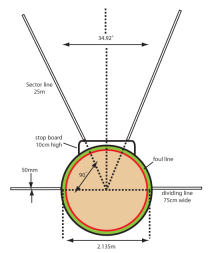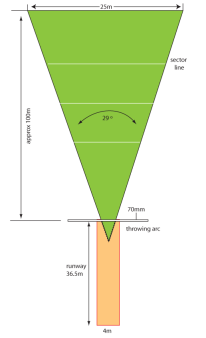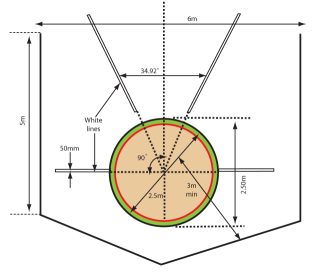Introduction
The four standard throwing events - shot put, discus, hammer and javelin - all involve the use of implements of various weights and shapes that are hurled for distance. In all throwing events, the object being thrown must land in a specified landing area. White lines 5cm wide delineate the area.
Shot put
The shot put involves "putting" (throwing in a pushing motion) a heavy metal ball (called the shot) as far as possible. The shot put facility includes a throwing circle, a stop-board and a landing sector. Competitors take their throw from inside a circle 2.135m in diameter, with a toe board approximately 10cm high at the front of the circle. The distance thrown is measured from the inside of the circumference of the circle to where the shot lands at its nearest disturbance of the soil.The throwing circle is made of bank iron, steel or other suitable material, the top of which is flush with the ground outside. The inside diameter of the throwing circle measures 2.135m (±5mm) and the rim at least 6mm in thickness, 70mm to 80mm deep and painted white.
The interior of the circle is constructed of concrete, asphalt or some other firm but not slippery material. The surface must be level and 1.4cm–2.6cm lower than the upper edge of the rim of the circle. A portable circle meeting these specifications is permissible.
The stop board is white and made of wood or other suitable material in the shape of an arc so that the inner edge coincides with the inner edge of the rim of the circle. It is placed mid-way between the sector lines, and constructed so that it can be firmly fixed to the ground. The board is 1.22m long on the inside, 11.2cm wide and 10cm high when firmly in position.

Javelin
The javelin throw is a throwing event where the object to be thrown is a spear-like object made of metal, fibreglass and, in some cases, carbon fibre. The facility for the javelin throw includes a runway, a throwing arc and a landing sector. The minimum length of the runway is 30m and the maximum 36.5m. It is marked by two parallel white lines 5cm wide and 4m apart.The throw is made from behind an arc of a circle drawn with a radius of 8m. The arc consists of a strip painted or made of wood 7cm wide. It is white and flush with the ground. Lines are drawn from the extremities of the arc at right angles to the parallel lines marking the runway. These lines are white, 75cm long and 7cm wide. The maximum lateral inclination of the runway is 1:100 and the overall inclination in the running direction 1:1000.

Hammer throw
The hammer throw is a throwing event where the object thrown is a heavy steel ball attached with a long wire (maximum length 122cm) to a handle. The facility for the hammer throw includes a throwing circle, protective cage and landing sector. It is usually combined with the facility for the discus throw.The throwing circle is the same as for the discus and shot put throw but has an inside diameter of 2.135m (±5mm). The hammer can be thrown from the discus circle provided the diameter of this circle is reduced from 2.50m to 2.135m by placing a circular ring inside.
The hammer throw cage is designed, manufactured and maintained to be capable of stopping a 7.260kg disc moving at a speed of up to 32m per second. There must be no danger of the disc ricocheting or rebounding back towards the athlete or over the top of the cage. If these requirements are satisfied, any form of cage design and construction can be used.
